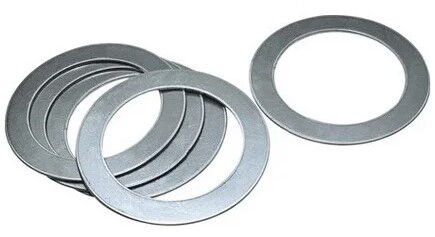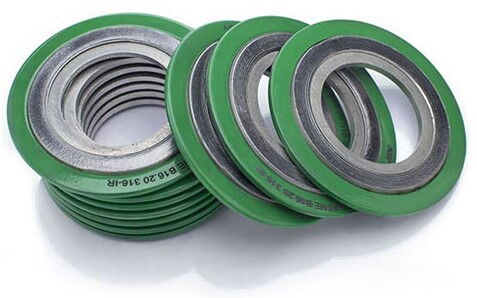In the industrial field, sealing technology is a key link to ensure the normal operation of equipment and prevent leakage. Graphite gaskets and spiral wound gaskets, as two common sealing materials, stand out among many sealing solutions for their excellent performance and wide range of applications. This article will give you an in-depth analysis of the characteristics, advantages, application fields, and differences between these two types of gaskets, helping you better choose the right sealing product.
The name graphite gasket may still be relatively unfamiliar to many people, but it plays a crucial role in the industrial field. Graphite gaskets are made by cutting or punching pure graphite sheets or metal-reinforced graphite sheets. With their unique physical and chemical properties, they have become an ideal choice for many industrial sealing applications.

Graphite gaskets have many outstanding sealing functions. They show excellent thermal stability, maintaining stable performance under high-temperature environments without deformation or damage caused by temperature changes. The self-lubricating property reduces friction and wear during use, extending service life. Corrosion resistance is a major highlight of graphite gaskets. They can resist the erosion of various chemical media, whether acidic, alkaline, or other corrosive substances. They can easily handle them. The characteristics of non-aging and non-brittleness mean that graphite gaskets can be used safely for a long time under harsh operating conditions, requiring very little maintenance and greatly reducing maintenance costs and downtime.
The inner liner material of graphite gaskets can be selected with different metal sheets to meet the needs of different working conditions. In terms of structural form, graphite gaskets also have multiple options, including no edge, inner edge, outer edge, and inner and outer edge. Graphite gaskets without edges are suitable for situations where the sealing requirements are relatively low, and they are convenient to install and replace. Graphite gaskets with inner or outer edges provide better sealing performance and can prevent leakage more effectively. Graphite gaskets with both inner and outer edges combine the advantages of the previous two, having higher sealing reliability and stability, suitable for occasions with extremely high sealing requirements.
The application range of graphite gaskets is very wide. They are widely used in the sealing parts of pipelines, valves, pumps, pressure vessels, heat exchangers, condensers, generators, air compressors, exhaust pipes, and refrigeration machines. In these pieces of equipment, graphite gaskets can effectively prevent the leakage of liquids or gases and ensure the safe operation of the equipment. For example, in industries such as petroleum, chemical, and pharmaceutical, graphite gaskets are often used for sealing various corrosive media. Their excellent corrosion resistance can effectively prevent medium leakage and ensure the safety and stability of the production process. Under high-temperature and high-pressure conditions, the stable performance of graphite gaskets makes them an ideal choice, capable of withstanding extreme working environments while maintaining good sealing effects.
Spiral wound gaskets are another type of sealing material widely used in the industrial sealing field. They are usually made of high-quality stainless steel winding strips such as SS 304 or SS 316, alternately wound in spiral layers with soft materials such as graphite, asbestos, PTFE, or non-asbestos fillers. This unique structure endows the spiral wound gasket with many excellent properties, making it the preferred choice in many industrial sealing applications.

Spiral wound gaskets have good compressibility and resilience, with multiple sealing paths and certain self-tightening functions. This means that during use, even when pressure and temperature change, the gasket can automatically adjust to maintain good sealing performance. It is not sensitive to surface defects of the flange sealing surface, does not stick to the flange sealing surface, and can partially eliminate the effects of pressure, temperature changes, and mechanical vibrations. This allows the spiral wound gasket to maintain excellent sealing performance under harsh conditions such as high temperature, low temperature, high vacuum, impact vibration, and cyclic alternating conditions, making it an ideal sealing choice.
The structural design of spiral wound gaskets is very flexible. They can select different metal strips and filler materials according to various working conditions. For example, flexible graphite can be chosen as the filler material for occasions requiring fire safety. If the gasket's effective compression load is limited, its structure and dimensions can be modified to achieve effective sealing. A spiral wound gasket can include an outer ring, an inner ring, or both. The outer ring centers the gasket with the flange and acts as a compression limiter. The inner ring not only provides additional radial strength but also reduces flange erosion and protects the sealing element. This flexible structural design allows spiral wound gaskets to adapt to various complex working conditions and meet different sealing requirements.
Spiral wound gaskets are widely used in industries such as petroleum, chemical, metallurgy, power generation, shipbuilding, gas, nuclear energy, aerospace, textile, pharmaceutical, and machinery. They are used in the static sealing parts of flange connections in pipelines, valves, pressure vessels, condensers, heat exchangers, towers, manholes, and handholes. In these fields, spiral wound gaskets, with their excellent sealing performance and good adaptability, have become indispensable sealing materials. For example, in the petrochemical industry, spiral wound gaskets are commonly used at the joints of pipelines and equipment to effectively prevent the leakage of petroleum and chemical media, ensuring the safety and stability of production. In the power industry, spiral wound gaskets are used in generators and boilers to ensure normal operation under high-temperature and high-pressure conditions.
Although graphite gaskets and spiral wound gaskets are both commonly used materials in the industrial sealing field, they differ in performance, structure, and applications.
Graphite gaskets have good corrosion resistance, high/low-temperature resistance, excellent compressibility and resilience, and high strength. They perform well under high-temperature and high-pressure environments, offering stable long-term operation, self-lubrication, and impermeability. Spiral wound gaskets, however, are superior in sealing performance, with excellent elasticity and self-tightening capability, adapting to pressure and temperature changes. In terms of corrosion resistance, graphite gaskets have a slight advantage, but spiral wound gaskets can also meet various sealing requirements by selecting suitable filler materials.
Graphite gaskets have relatively simple structures, mainly made by cutting or punching pure graphite sheets or metal-reinforced graphite sheets, with forms such as no edge, inner edge, outer edge, and inner and outer edge. Spiral wound gaskets have more complex structures, composed of alternating metal strips and filler materials, and can include outer and inner rings to enhance sealing performance and stability.
Graphite gaskets are mainly used in petrochemical, aerospace, and boiler industries for high-temperature and high-pressure applications, suitable for sealing various corrosive media. Spiral wound gaskets are widely used in the chemical, petroleum, and power industries, especially where pressure and temperature fluctuate greatly. When selecting sealing materials, it is necessary to consider working conditions and sealing requirements comprehensively, as well as performance, structure, and cost, to select the most suitable gasket type.
When selecting graphite gaskets and spiral wound gaskets, besides considering performance and application range, cost must also be considered. Graphite gaskets are relatively expensive due to their special raw materials and complex manufacturing process. However, their excellent corrosion resistance and high-temperature and high-pressure performance make them irreplaceable in certain fields. Spiral wound gaskets are relatively more economical and can meet most industrial sealing needs. The choice should be based on specific working conditions and budget, balancing performance and cost to choose the most suitable sealing solution.
Graphite gaskets and spiral wound gaskets are two important materials in the industrial sealing field, each with unique properties and advantages. Graphite gaskets, with their excellent corrosion resistance, high/low-temperature tolerance, and good compressibility and resilience, are ideal for high-temperature, high-pressure, and corrosive medium sealing. Spiral wound gaskets, with their outstanding sealing performance, good elasticity, and self-tightening capability, are widely used in various industrial sealing applications. When selecting sealing materials, it is necessary to consider working conditions, sealing requirements, and budget, and comprehensively evaluate performance, structure, and cost to select the most suitable gasket type. Whether it is a graphite gasket or a spiral wound gasket, both provide reliable sealing solutions for industrial applications, ensuring the safe operation of equipment and the stable progress of production processes.
